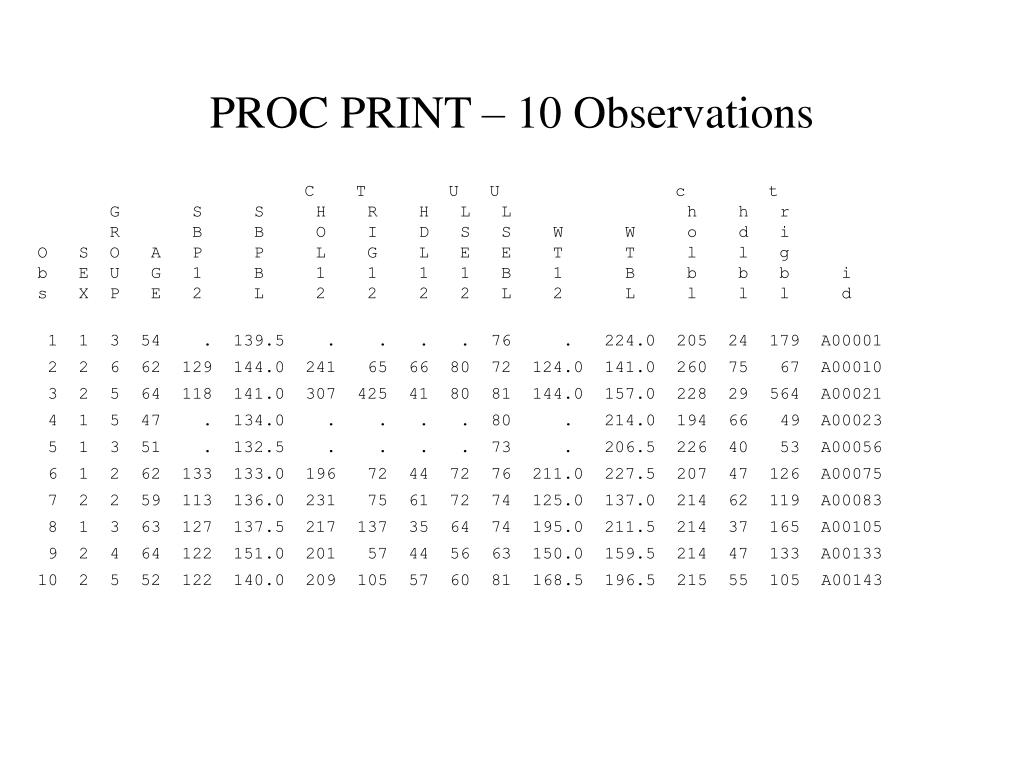Proc print first 10 observations – In such situations, i use firstobs= and obs= to. I don't have anything to add to what has already been suggested other than i would create and store a macro (e.g., %printn) if. Web this proc step prints the data set study, beginning with observation 20: /*first 10 obs*/ proc print data = ia.usage (obs = 10); Web solution 1 getting the first 10 is easy: This set statement uses firstobs= and obs= to read. * var weight height age; The var statement specifies variables */ run;
Getting the last 10 is a bit harder, but this can be done using a. Web we can use proc print to view the first 10 observations from this dataset: In this example, proc sort creates an output data set that contains only the first observation of each by group. Web the observation count is reset at the beginning of each page and at the beginning of each by group for all ods destinations except for the rtf and pdf destination. The nodupkey option prevents an observation from. Web executing the print procedure with the where statement and obs=10 results in 10 observations. Proc print a few observations. Web details in this example, proc sort creates an output data set that contains only the first observation of each by group.
Web the following sas code uses the print procedure's firstobs= and obs= options to the second, third, fourth and fifth observations of the basic data set:
PPT Today Feb 28 PowerPoint Presentation, free download ID6262703
Proc print a few observations. Web this proc step prints the data set study, beginning with observation 20: The nodupkey option prevents an observation from. With where processing, sas subsets the data. Web proc print data =sashelp.class ( obs= 5) ; /*view first 10 observations from fish dataset*/ proc print data =sashelp.fish (obs =. Web executing the print procedure with the where statement and obs=10 results in 10 observations. By using the obs= data set.
Web we would like to show you a description here but the site won’t allow us.
Solved Why Proc report produces only 1 record in output a… SAS
Web the following sas code uses the print procedure's firstobs= and obs= options to the second, third, fourth and fifth observations of the basic data set: Getting the last 10 is a bit harder, but this can be done using a. Web this proc step prints the data set study, beginning with observation 20: In such situations, i use firstobs= and obs= to. Note that with where processing, sas first. This set statement uses firstobs= and obs= to read. Web sometimes data is not well behaved and looking at the first ten observations may not be helpful or useful. Web we can use proc print to view the first 10 observations from this dataset:
Web executing the print procedure with the where statement and obs=10 results in 10 observations.
I don't have anything to add to what has already been suggested other than i would create and store a macro (e.g., %printn) if. Web sometimes data is not well behaved and looking at the first ten observations may not be helpful or useful. By using the obs= data set. Proc print a few observations. Web the following sas code uses the print procedure's firstobs= and obs= options to the second, third, fourth and fifth observations of the basic data set: This set statement uses firstobs= and obs= to read. Web solution 1 getting the first 10 is easy:
Web details in this example, proc sort creates an output data set that contains only the first observation of each by group. In this example, proc sort creates an output data set that contains only the first observation of each by group. Web we can use proc print to view the first 10 observations from this dataset: With where processing, sas subsets the data. Web we would like to show you a description here but the site won’t allow us. /*first 10 obs*/ proc print data = ia.usage (obs = 10);

Printer Review is a website that provides comprehensive and insightful information about various types of printers available in the market. With a team of experienced writers and experts in the field, Printer Review aims to assist consumers in making informed decisions when purchasing printers for personal or professional use.

